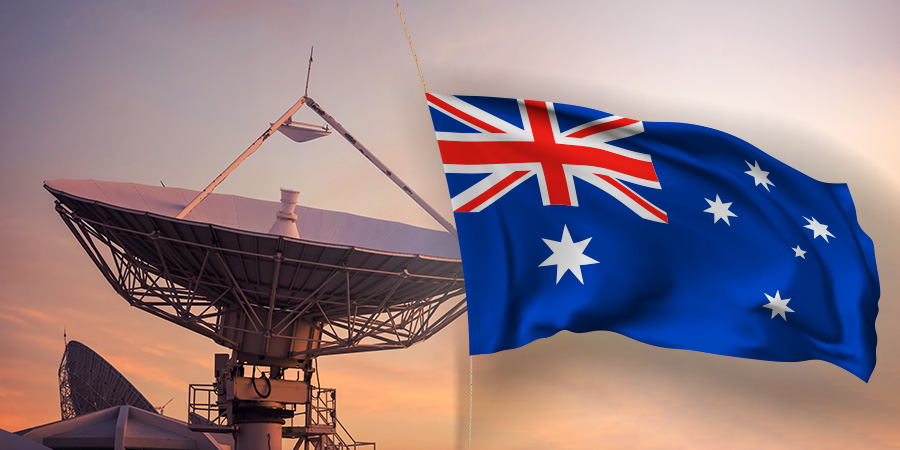
In an exclusive interview with Samer Halawi, chief commercial officer, Intelsat, Telecom Review has gained insights about network convergence and the important role of satellites for modern connectivity. In addition, we are enlightened on the innovating steps the leading satellite communications provider has taken to serve the needs of telcos and transform into reality the needs of businesses and governments across numerous verticals.
In general, satellites provide a variety of mobile and fixed communications services. Intelsat offers a wide range of solutions delivered by utilizing emerging software-defined and 5G technologies, maintaining its global competitiveness within the satellite industry.
With almost six decades in the satellite industry, what is the current global footprint and coverage of Intelsat?
Intelsat operates the world’s largest integrated satellite and terrestrial network. We own and operate 52 satellites and eight teleports that cover 99% of the world’s population. We also have a record-breaking 10 more satellites currently in production, which will expand our coverage and scope even further.
Intelsat supports customers in 200 countries around the world. We serve over 3,000 commercial aircrafts and eight of the world’s top 20 global carriers. We’re also the largest provider of connectivity for the offshore oil and gas market. Seven of the world’s top 10 mobile operators work with us. We reach more than two billion people via TV and radio, and we’re the largest provider of satellite services to the US government.
Out of all the solutions Intelsat offers, how do you particularly serve the needs of telecommunications companies around the world?
Telecommunications companies have a wide variety of operations, from internet service for homes and businesses to mobile network coverage. Intelsat enables these companies to connect their operations and customers with a variety of integrated space and terrestrial based services and solutions.
Telcos can leverage Intelsat’s services to increase branch-office resiliency and application performance in their SD-WAN deployments. We also offer fiber and teleport services that provide a cost-effective alternative to building and owning satellite infrastructure. And our cellular backhaul managed service offers mobile network operators (MNOs) a cost-effective, end-to-end solution for expanding coverage into rural and hard-to-reach places.
Intelsat works with telecommunications companies around the world to identify the right solution or set of professional services that will help them achieve their business objectives. We’re doubling down on our customer commitment this year and launching several new customer support centers across multiple time zones, regions and languages. Our in-region teams speak our customers’ language and understand their specific culture, priorities, teams, and service platforms.
Can you elaborate on how the Intelsat global network connects possibility to reality for businesses and governments?
We’re known for solving some of the toughest connectivity challenges.
Right now, for example, we’re helping scientists in Antarctica quickly communicate their research findings to colleagues around the world, and we’re equipping rural cocoa farmers in Peru with real-time crop pricing on their mobile phones – if our customers can imagine the possibility, we’re here to help them make it a reality.
Another great example of this is the work we recently did with one of the leading telecommunications service providers in Japan. They were looking for a way to quickly and cost-effectively provide 3G and 4G coverage to rural areas that are hard to reach because of the island’s topography. Intelsat provided a complete, end-to-end cellular backhaul managed service to meet this customer’s needs, including a fully staffed, 24×7 network operations center in Japan.
In today’s era, many players are involved in connectivity. Is Intelsat ready to converge with other service providers? What is Intelsat’s role when it comes to network convergence?
We’re more than ready, we’re leading the way. Intelsat acquired Gogo’s Commercial Aviation business in December, and we’re now the leading global provider of inflight broadband services to commercial airlines, including to nearly half of the world’s top 20 global carriers. For us, the vertical integration made sense – combining the world’s largest satellite operator with the leading provider of commercial inflight connectivity (IFC) services will deliver unprecedented innovation and long-term value to our commercial airline customers.
In all of our verticals, we partner across the ecosystem to deliver the best for our customers. Right now, for example, Intelsat is pioneering the land-mobile connectivity market with a whole host of partners, including Kymeta, Starwin, Satcube, and GRC. As a result, emergency response and industrial vehicle fleets, railroads and other Communications-on-the-Move (COTM) applications across the globe are now able to stay connected wherever they go on our seamless global network.
Intelsat’s leadership position in the maritime market is also a result of the strong partnerships that we have in place today. We’re defining the future of maritime connectivity with KVH, Navarino, and others – making it easier and more affordable than ever to add user-friendly, high-performance broadband to any class of ship. We also work very closely with our wholesale bandwidth partners, including Marlink, SpeedCast, and Global Eagle, enabling them to provide exceptional end-to-end services to their customers in maritime, as well as other segments.
Our customer-focused approach ensures our customers get the best quality of service and coverage. By working with Intelsat, they are opting into an ecosystem that we have spent decades developing with our partners. The value that Intelsat has to offer, from satellite diversity to terrestrial connectivity, is augmented by the value-added services that our partners also offer.
We are also actively engaged in bolstering the great momentum that we are seeing in our managed services space, particularly on Flex. Our channel partners have been instrumental to the growth that we are seeing today in maritime and land mobility on Flex, with a lot of that driven by their ability to reach new customers, introduce exceptional value-added services and exhibit agility in deployments and customer service. With FlexMaritime, FlexMove, FlexGround, and FlexEnterprise, Intelsat and our partners are laser-focused on delivering a great customer experience.
We continue to work with our partners on evolving our customer experience. We constantly evaluate new platforms, terminal technologies and other aspects of our space and land connectivity assets to ensure we are providing our customers with the best possible experience out there. Our leadership position and market experience help us aggregate feedback from our partners and customers, and that helps us shape how our products and services evolve to better address growing demand and higher expectations.
Intelsat claims that innovation begins at connection. What are the company’s future plans to stay at the forefront of the satellite industry?
For starters, Intelsat is at the forefront of the move to software-defined technologies. In January, we announced a contract with Airbus for two software-defined satellites, which we can dynamically adjust and configure while in orbit, significantly improving the economic equation for our customers and making our network even more flexible, accessible, relevant, and cost-effective for them.
We also think small GEO satellites offer unique advantages, that make them particularly optimized to service a certain geography or a certain application; and you can launch multiple small GEOs at a time.
In addition to our space assets, we’re also virtualizing our ground infrastructure, further solidifying the power and reach of our extensive fiber network with our strategically located teleport system – all of which integrates seamlessly with our satellite network. This integrated network combines the most cost-effective balance between space and terrestrial assets, enabling our customers to rapidly deploy new end-to-end services with minimal investment, maximum flexibility, and optimal reliability and security.
Intelsat is building a 5G ecosystem – compatible with 3GPP – that is a flexible, adaptable technology framework, fully capable of supporting multiple access technologies and responding to the ever-increasing expectations and demands of end users. Working closely with the mobile operators, we can easily leverage and deliver on the promise of 5G.
We head up the Non-Terrestrial Networks 5G Working Group (NTN 5G WG) for the Alliance for Telecommunications Industry Solutions (ATIS), where we’re working to align technical proposals between the satellite community and major terrestrial 3GPP ecosystem contributors, including terrestrial network operators, radio access network (RAN) suppliers, and chipset vendors. The goal is to ensure an end-to-end ecosystem standard for unified 5G networks by mid-2021, which will be transformative.
We’re also investing in next-generation satellite-imaging technology with BlackSky, and exploring High-Altitude Platform Systems (HAPS) technology with partners like AT&T, Nokia, and platform providers. As the foundational architects of satellite technology, we’re able to bring our expertise, strength and scale to bear on a number of collaborative efforts like these that are aimed at accelerating innovation, connecting more people in more places and defining or scaling entirely new markets.
We’re fortunate to be making all of these investments from a position of strength. Intelsat already operates the largest-capacity fleet of advanced commercial satellites in the world, providing seamless, secure global coverage with performance others just can’t match. We’re solidifying our position as the trusted global network provider with the best performance, the best reach, and the best economics for our customers.
What is your opinion regarding the debate on the efficiency of using satellites for connectivity? Will satellites remain sustainable in the long run?
No question. Satellites can reach places terrestrial-only networks can’t, and in many cases, space-based technology is more reliable than terrestrial technology – particularly in areas prone to natural disasters and fiber outages. Perhaps most importantly though, satellites are an incredibly cost-effective way to reach more people in more places.
Let me give you some specifics. To connect multiple sites across large rural geographic areas, you need to run fiber backhaul to each cell site. Just 10 miles of fiber backhaul can cost around $186,000; when factoring in multiple rural cell sites, costs quickly add up. Additionally, it can take up to a year to run 10 miles of fiber to some rural cell sites.
Using microwave backhaul for connecting cell sites in these rural areas is also challenging. One complete microwave relay system can cost an average of $70,000. The investment further increases when factoring in multiple hops required over long distances or around obstacles like mountains.
Satellite technology offers MNOs a faster, more cost-efficient means of backhauling 4G and 5G coverage, particularly to rural and remote areas. For starters, geostationary satellite networks enable MNOs to backhaul as many cell sites as needed, wherever they are needed, without the topographical constraints or long lead times typical of terrestrial backhaul approaches. Instead of taking up to a year or more to connect rural cell sites using terrestrial backhaul, sites can be connected by satellite to an MNO’s core network in a matter of weeks.
Satellite networks can also dynamically distribute a single pool of capacity across an entire network of rural sites based on planned per-site demand, while meeting quality-of-service requirements. As a result, the cost of satellite capacity is dynamically distributed across the entire network of sites.







